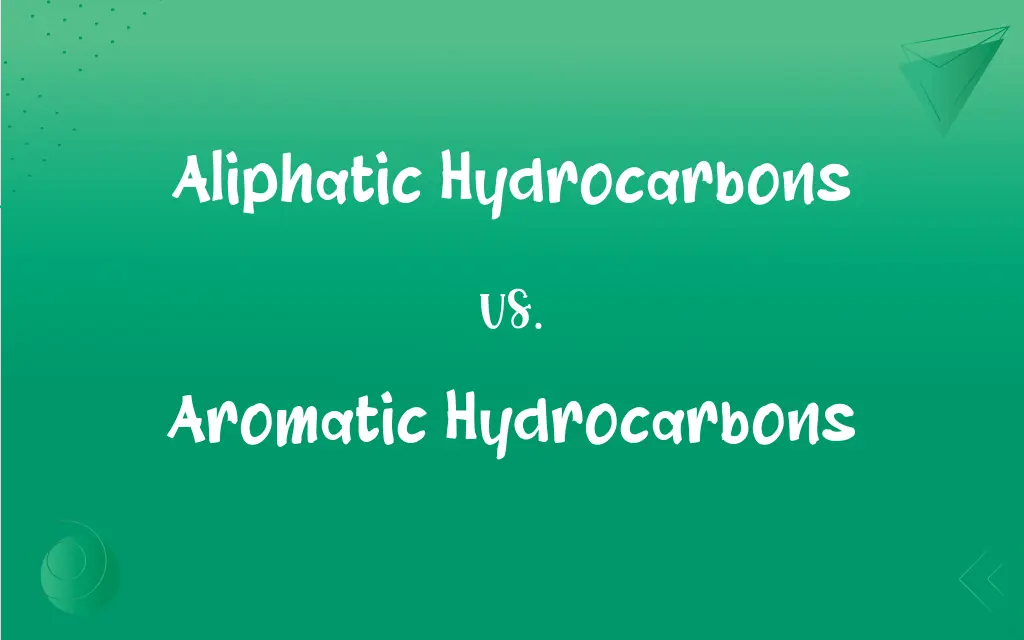Aliphatic Hydrocarbons vs. Aromatic Hydrocarbons: What's the Difference?
Edited by Aimie Carlson || By Janet White || Published on March 14, 2024
Aliphatic hydrocarbons consist of linear or branched chains without rings, while aromatic hydrocarbons contain ring structures with delocalized electrons.

Key Differences
Aliphatic hydrocarbons are characterized by their simple linear or branched structures, which can be saturated (alkanes) or unsaturated (alkenes and alkynes). These compounds are found in many natural sources and are used in various industrial applications due to their reactivity and versatility. In contrast, aromatic hydrocarbons are known for their stable ring structures, which include benzene rings with delocalized electrons, giving them unique chemical properties such as resistance to some types of chemical reactions.
The chemical behavior of aliphatic hydrocarbons is largely influenced by the presence of single, double, or triple bonds, which determine their reactivity and interactions with other substances. For instance, alkenes and alkynes participate in addition reactions due to their unsaturated nature. Aromatic hydrocarbons, however, exhibit electrophilic substitution reactions as their primary chemical activity, a consequence of their electron-rich aromatic rings.
Aliphatic hydrocarbons are widely used as fuels, solvents, and in the synthesis of plastics, while their simplicity and reactivity make them fundamental to organic chemistry. Aromatic hydrocarbons, with their distinctive aromaticity, are crucial in the manufacture of dyes, pharmaceuticals, and explosives. Their stable ring structure makes them less reactive under certain conditions compared to their aliphatic counterparts.
Environmental impact and health risks differ significantly between aliphatic and aromatic hydrocarbons. Aliphatics, especially the shorter chains, tend to be more volatile and can contribute to air pollution and health issues upon inhalation. Aromatics, on the other hand, are often more toxic and carcinogenic, posing greater risks to human health and the environment, especially when released in large quantities.
Both aliphatic and aromatic hydrocarbons play vital roles in chemistry and industry, their structures confer distinct physical and chemical properties. Aliphatic hydrocarbons' versatility stems from their varied structures of chains and rings, whereas aromatic hydrocarbons' stability and unique reactions are derived from their ring structures with delocalized electrons.
ADVERTISEMENT
Comparison Chart
Structure
Linear or branched chains
Ring structures with delocalized electrons
Type of Bonds
Single, double, or triple bonds
Delocalized π bonds in rings
Reactivity
Varied, based on saturation
Stable, undergoes substitution reactions
Common Uses
Fuels, solvents, plastics
Dyes, pharmaceuticals, explosives
Environmental and Health Impact
Volatile, can be toxic
Often more toxic and carcinogenic
ADVERTISEMENT
Aliphatic Hydrocarbons and Aromatic Hydrocarbons Definitions
Aliphatic Hydrocarbons
Aliphatic hydrocarbons are a key component of organic chemistry and industrial applications.
Butane, used in lighters, is another example of an aliphatic hydrocarbon.
Aromatic Hydrocarbons
The stability of aromatic hydrocarbons comes from their electron-rich aromatic rings.
Naphthalene, used in mothballs, demonstrates the stability of aromatic hydrocarbons.
Aliphatic Hydrocarbons
Alkanes are the simplest form of aliphatic hydrocarbons with only single bonds.
Methane, found in natural gas, is an alkane.
Aromatic Hydrocarbons
Despite their utility, aromatic hydrocarbons can be toxic and are environmentally hazardous.
Xylene, an aromatic hydrocarbon, poses health risks with prolonged exposure.
Aliphatic Hydrocarbons
Aliphatic hydrocarbons can be saturated or unsaturated based on their bonds.
Ethylene, a key industrial chemical, is an unsaturated aliphatic hydrocarbon.
Aromatic Hydrocarbons
Aromatic hydrocarbons play a crucial role in the synthesis of dyes and pharmaceuticals.
Phenol, derived from aromatic hydrocarbons, is used in the production of plastics.
Aliphatic Hydrocarbons
Alkenes and alkynes are unsaturated aliphatic hydrocarbons with double and triple bonds respectively.
Acetylene, used in welding, is an alkyne.
Aromatic Hydrocarbons
Aromatic hydrocarbons are known for their distinctive smell and chemical resistance.
Toluene is used in paint thinners and is an aromatic hydrocarbon.
Aliphatic Hydrocarbons
Aliphatic hydrocarbons are organic compounds with straight or branched chains.
Propane, a gas used for heating, is an aliphatic hydrocarbon.
Aromatic Hydrocarbons
Aromatic hydrocarbons contain rings with delocalized electrons, providing stability.
Benzene, a solvent in many industries, is an aromatic hydrocarbon.
FAQs
How are aliphatic hydrocarbons used in industry?
They serve as fuels, solvents, and in the manufacture of plastics and synthetic fibers.
What defines an aliphatic hydrocarbon?
Aliphatic hydrocarbons are composed of carbon and hydrogen atoms arranged in straight or branched chains.
What are aromatic hydrocarbons?
Aromatic hydrocarbons feature one or more benzene rings with delocalized electrons.
Can aliphatic hydrocarbons be unsaturated?
Yes, aliphatic hydrocarbons can be unsaturated, containing double or triple bonds (alkenes and alkynes).
Why are aliphatic hydrocarbons important in organic chemistry?
They are fundamental to understanding chemical reactions and organic synthesis.
How do aliphatic and aromatic hydrocarbons differ in structure?
Aliphatic hydrocarbons have linear or branched structures, while aromatic hydrocarbons have ring structures.
What is the significance of delocalized electrons in aromatic hydrocarbons?
Delocalized electrons give aromatic hydrocarbons their chemical stability and unique reactivity.
Are all aromatic hydrocarbons toxic?
Many aromatic hydrocarbons are toxic, but their toxicity levels can vary widely.
Do aliphatic hydrocarbons have isomers?
Yes, aliphatic hydrocarbons can have structural isomers due to different arrangements of their atoms.
What environmental concerns are associated with aromatic hydrocarbons?
Aromatic hydrocarbons can be more toxic and carcinogenic, posing risks to health and the environment.
How do aromatic hydrocarbons exhibit resonance?
The delocalized electrons in aromatic hydrocarbons allow for resonance, stabilizing the molecule.
What role do aromatic hydrocarbons play in manufacturing?
Aromatic hydrocarbons are used to produce dyes, pharmaceuticals, and various chemicals.
What is the simplest aromatic hydrocarbon?
Benzene is considered the simplest aromatic hydrocarbon.
How does the reactivity of aliphatic hydrocarbons compare to aromatic hydrocarbons?
Aliphatic hydrocarbons are generally more reactive due to the presence of single, double, or triple bonds, compared to the stable aromatic ring structure of aromatic hydrocarbons.
What is a common use of alkanes?
Alkanes are primarily used as fuels, such as propane and butane.
How are aromatic hydrocarbons identified?
Aromatic hydrocarbons are identified by their unique ring structure and the presence of delocalized electrons.
What is an example of a cyclic aliphatic hydrocarbon?
Cyclohexane is an example, which does not contain delocalized electrons and is not aromatic.
Can aliphatic hydrocarbons form rings?
Yes, but when aliphatic hydrocarbons form rings without delocalized electrons, they are not considered aromatic.
Why are aromatic hydrocarbons used in explosives?
Their stable structure can be modified to release a significant amount of energy rapidly.
What are polycyclic aromatic hydrocarbons (PAHs)?
PAHs are compounds containing multiple aromatic rings, known for their persistence in the environment and potential health risks.
About Author
Written by
Janet WhiteJanet White has been an esteemed writer and blogger for Difference Wiki. Holding a Master's degree in Science and Medical Journalism from the prestigious Boston University, she has consistently demonstrated her expertise and passion for her field. When she's not immersed in her work, Janet relishes her time exercising, delving into a good book, and cherishing moments with friends and family.
Edited by
Aimie CarlsonAimie Carlson, holding a master's degree in English literature, is a fervent English language enthusiast. She lends her writing talents to Difference Wiki, a prominent website that specializes in comparisons, offering readers insightful analyses that both captivate and inform.































































